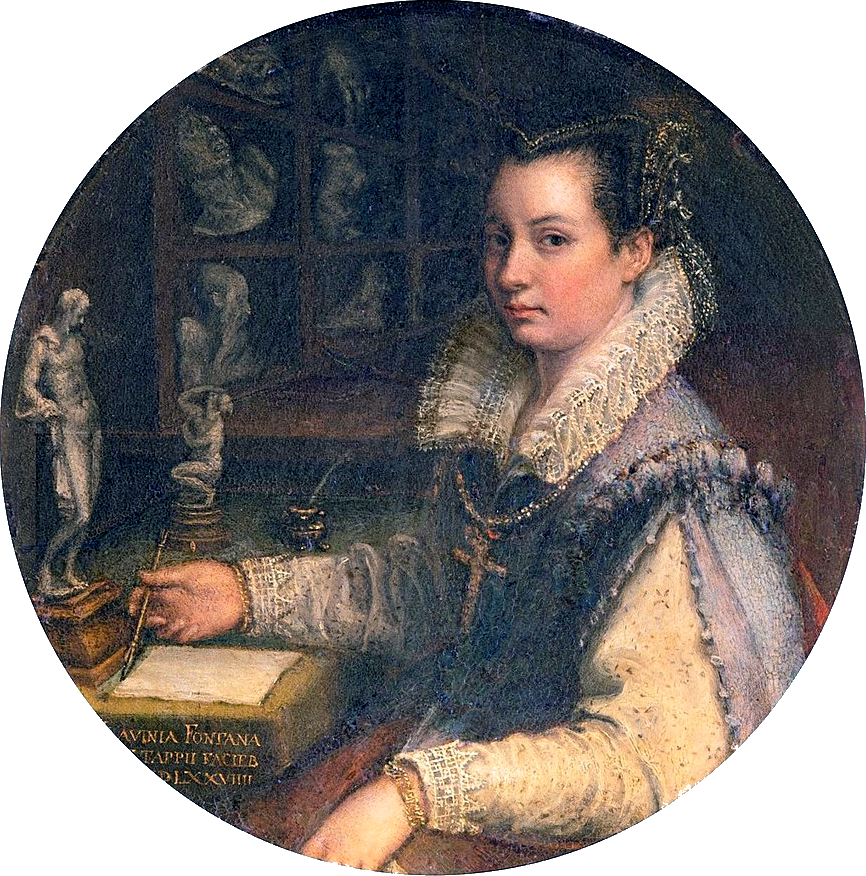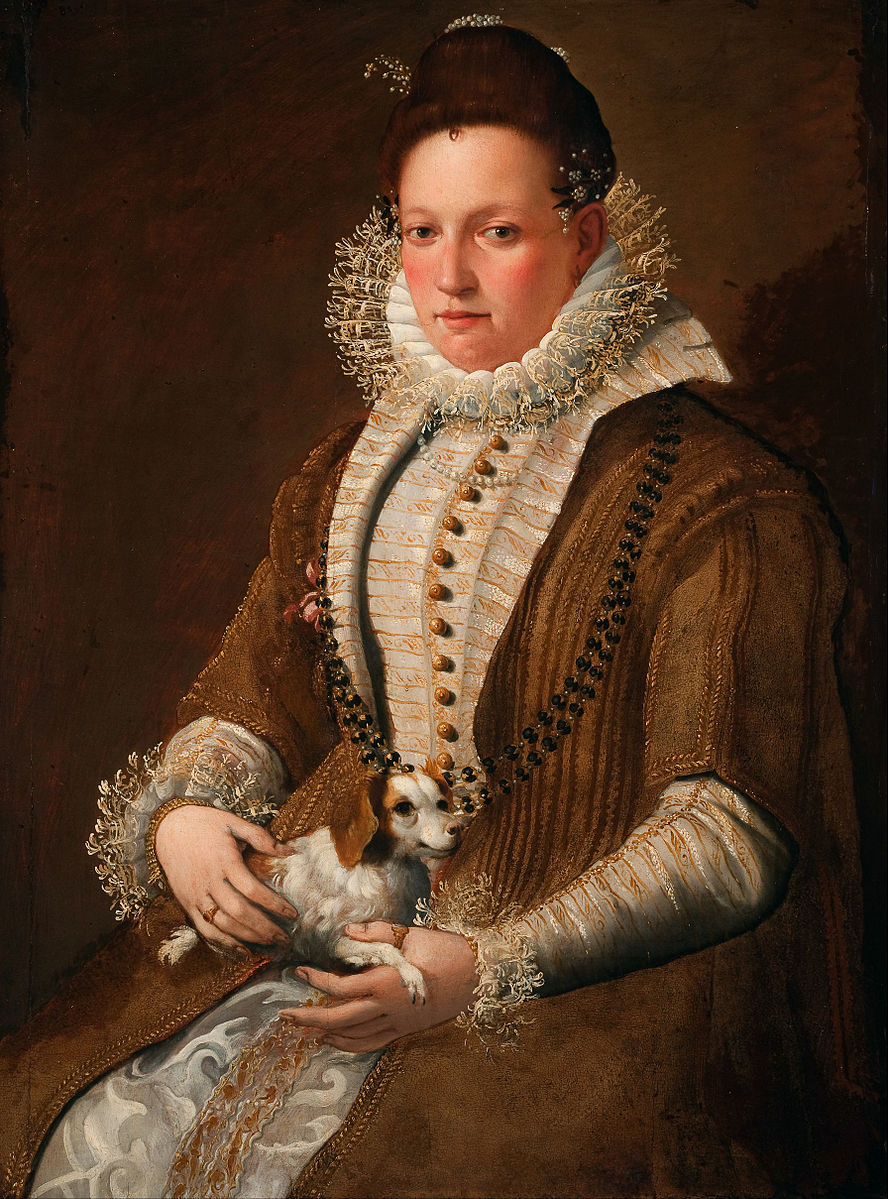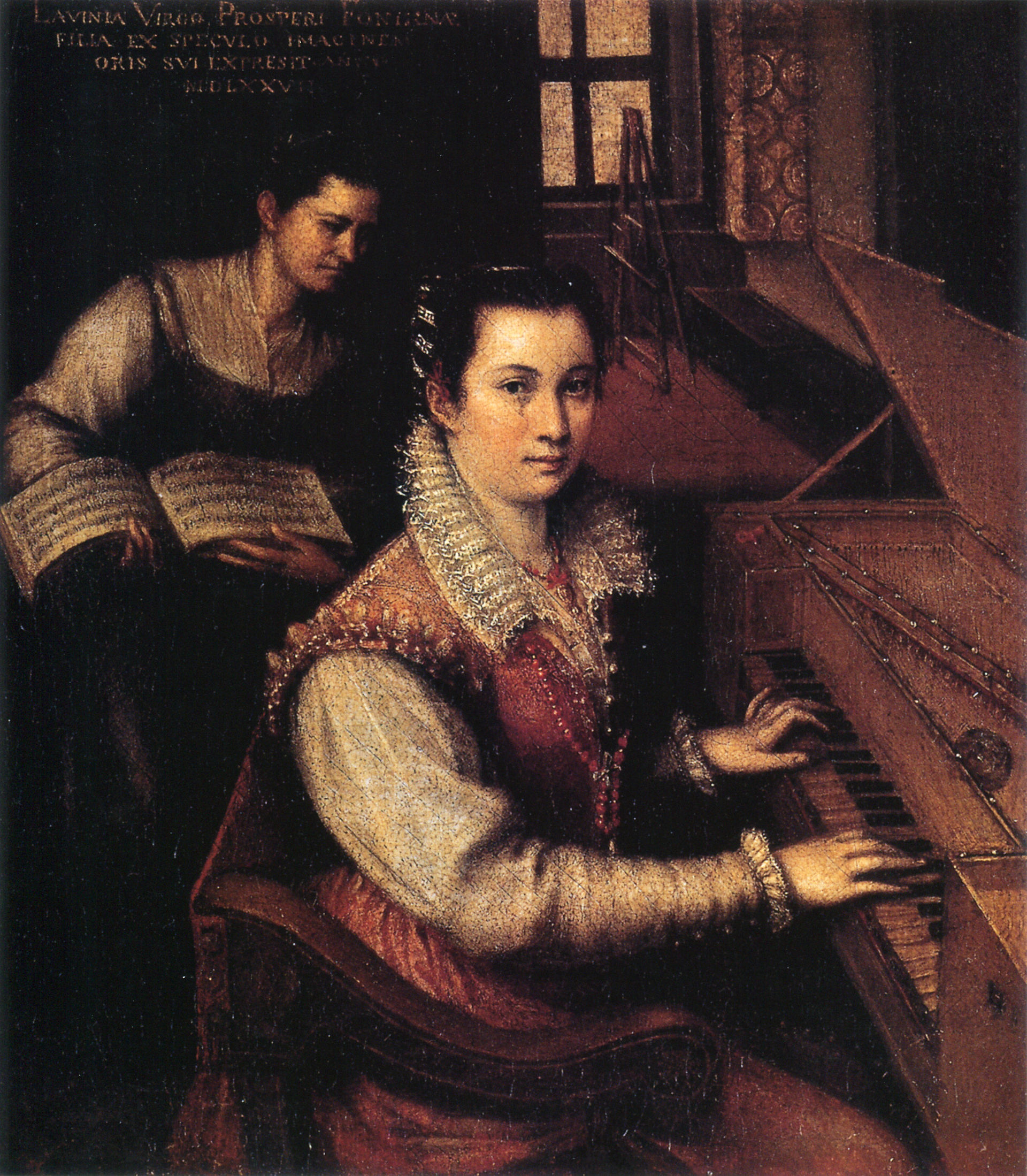Lavinia Fontana
Active in: Italy
Biography
Among the earliest women to pursue a professional career as an artist, Lavinia Fontana was born in Bologna in 1552. Her father, Prospero Fontana (1512–1597), was a painter and she trained with him in his studio. In 1577, she married the artist Gian Paolo Zappi and together the couple had eleven children. One of her earliest paintings, Christ with the Symbols of the Passion, was painted when Fontana was just twenty-four years old. Soon after, she began to paint small devotional paintings on copper to generate a commercial market for her work. She attended classes at the Università di Bologna and in 1580, was listed among the city’s donne addottrinate, or “women with doctorates.”
By the mid-1580s, she was a highly sought portraitist for Bolognese noblewomen. As Fontana became more successful, Zappi managed their household and served as both an agent and assistant for his wife, securing portrait commissions and painting background elements in her studio. In 1604, Fontana and her family were invited to Rome by Pope Clement VIII (1526–1605). She was subsequently appointing a portraitist in the court of Pope Paul V (1550–1621) and elected to the Accademia di San Luca. In addition to portraits, she painted large-scale canvases with religious and mythological themes.
While in Rome, she received many honors for her artistic achievements, including a bronze portrait medallion cast by Felice Antonio Casoni (1559–1634) in 1611. Fontana died in Rome on August 11, 1614 and was buried at Santa Maria sopra Minerva. She was outlived by only three of her eleven children.
Selected Works

Lavinia Fontana, Christ with the Symbols of the Passion, 1576. Oil on panel, 40 x 30 cm. El Paso Museum of Art.

Lavinia Fontana, Self-Portrait in the Studio, 1579. Oil on copper, 15.7 cm diameter. Galleria degli Uffizi, Florence.

Lavinia Fontana, Portrait of a Lady with a Dog, n.d. Oil on panel, 97.1 x 72.4 cm. Auckland Art Gallery.

Lavinia Fontana, Self-Portrait at the Clavichord with a Servant, 1577. Oil on canvas, 27 x 24 cm. Accademia di San Luca, Rome.

Lavinia Fontana, Portrait of a Noblewoman, ca. 1580. Oil on canvas, 115 x 89.5 cm. National Museum of Women in the Arts.
Circle
Daughter of
Painter Prospero Fontana (1512-1597)
Wife of
Gian Paolo Zappi
Sitter for
Felice Antonio Casoni
Bibliography
Baglione, Giovanni. Le Vite dé pittori, scultori et architetti dal pontificato di Gregorio XIII del 1572, in fino a' tempi di Papa Urbano ottavo nel 1642. Rome: Andrea Fei Galiciana, 1642.
Bohn, Babette. “Female Self-portraiture in Early Modern Bologna.” Renaissance Studies 18, no. 2 (June 2004): 239–86.
Borghini, Raffaello. Il Riposo. Florence: Apresso Giorgio Marescotti, 1584.
Borzello, Frances. Seeing Ourselves: Women’s Self-Portraits. New York: Harry N. Abrams, Inc., 1998.
Cantaro, Maria Teresa. Lavinia Fontana bolognese:“pittora singolare.” Milan and Rome: Jandi Sapi Editori, 1989.
Chadwick, Whitney. Women, Art, and Society. London: Thames and Hudson, 1990.
Cheney, Liana. “Lavinia Fontana’s Nude Minervas.” Woman’s Art Journal (2015): 30–40.
Cheney, Liana. Lavinia Fontana’s Mythological Paintings: Art, Beauty, and Wisdom. Newcastle upon Tyne, UK: Cambridge Scholars Publishing, 2020.
Dabbs, Julia, ed. Life Stories of Women Artists, 1550–1800. London: Ashgate Publishing, 2009
Findlen, Paula, ed. The Italian Renaissance: The Essential Readings. London: Blackwell Publishing, 2002.
Fortunati Pietrantonio, Vera. La pittura bolognese del ’500. Bologna: Grafis Edizioni, 1986.
Fortunati, Vera. Lavinia Fontana, 1552–1614, Milan: Electa, 1994.
Fortunati, Vera. Lavinia Fontana of Bologna, 1552–1614. Washington, DC: National Museum of Women in the Arts; Milan: Electa, 1998.
Galli, Romeo. Lavinia Fontana: pittrice,1552–1614. Imola: Cooperativa Tip. Edit. Paolo Galeati, 1940.
Gaze, Delia. Concise Dictionary of Women Artists. New York: Routledge, 2013.
Hansen, Morten Steen, and Jonathan A. Spicer, eds. Masterpieces of Italian Painting, The Walters Art Museum. London: Giles, 2005.
Harris, Anne Sutherland, and Linda Nochlin. Women Artists: 1550–1950. Los Angeles: Los Angeles County Museum of Art, 1976.
King, Catherine. “Looking at Sight: Sixteenth-century Portraits of Woman Artists.” Zeitschrift für Kunstgeschichte 58 (1995): 381–406.
Malvasia, Carlo Cesare. Felsina Pittrice: vite dei pittori Bolognese. Bologna: Erede di Domenico Barbieri, 1678.
Mancini, Giulio. Considerazione sulla pittura c. 1614–21, Rome. In Life Stories of Women Artists, 1550–1800, translated and edited by Julia Dabbs, 82–84. London: Ashgate Publishing, 2009.
McIver, Katherine A. “Lavinia Fontana’s Self-portrait Making Music.” Woman’s Art Journal 19, no. 1 (1998): 3–8.
Murphy, Caroline P. “Lavinia Fontana: The Making of a Woman Artist.” In Women of the Golden Age: An International Debate on Women in Seventeenth-Century Holland, England and Italy, edited by E. Kloek, N. Teeuwen, and M. Huisman, 171–85. Hilversum: Verloren, 1994.
Murphy, Caroline P. “Lavinia Fontana and le dame della città: Understanding Female Artistic Patronage in Late Sixteenth-century Bologna.” Renaissance Studies 10, no. 2 (June 1996): 190–208.
Murphy, Caroline P. “Lavinia Fontana and Female Life Cycle Experience in Late Sixteenth-century Bologna.” In Picturing Women in Renaissance and Baroque Italy, edited by G. A. Johnson and S. F. M. Grieco, 111–38. Cambridge University Press, 1997.
Murphy, Caroline. Lavinia Fontana: A Painter and Her Patrons in Sixteenth-Century Bologna. New Haven: Yale University Press, 2003.
Nochlin, Linda, and Ann Sutherland Harris. Women Artists, 1550–1950. Los Angeles: Los Angeles County Museum of Art, 1976–77.
Ruiz Gómez, Letitia, ed. A Tale of Two Women Painters: Sofonisba Anguissola and Lavinia Fontana. Madrid: Museo del Prado, 2019.
Sassu. Giovanni. “Intorno ad un dipinto a due mani: Tra Prospero e Lavinia Fontana.” Carrobbio 23 (1997): 81–91.
Smyth, Frances P., and John O'Neill, ed. The Age of Correggio and the Carracci: Emilian Painting of the 16th and 17th Centuries. Washington DC: National Gallery of Art, 1986.
Tufts, Eleanor. “Lavinia Fontana, Bolognese Humanist.” Le arti a Bologna e in Emilia dal XVI al XVII secole/Receuils d’actes des Congrès internationaux d’histoire de l’art: Bologna (1982): 129–34.


